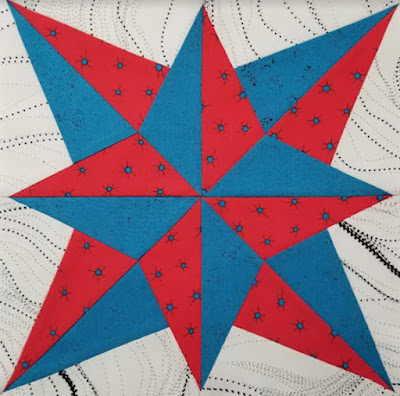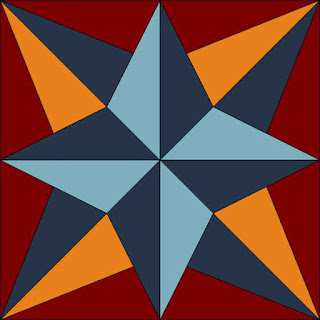Block # 5 Mariner's Compass by Becky Brown
Mariner's Compass recalls a Southern family, the Alstons who lived near the Atlantic.
Charleston, South Carolina under siege in 1780 by Alonzo Chappell
The Revolutionary War came close to home for the (Alstons) Allstons of Georgetown, South Carolina in fall 1780 when a skirmish took place near their plantations on the Waccamaw River. The British controlled the area but Colonel Francis Marion of the Continental rebels wanted local supplies and hoped a victory would inspire more revolutionary loyalty in the neighborhood.
Georgetown County north of Charleston on the Atlantic.
"Many of my people has left me & gone over to the Enemy, for they think we have no army coming in & have been Deceived, as we hear nothing from you in a great while...." Francis Marion to his commander.
During the short encounter Marion lost his nephew and the battle to the British.
Several family plantations were on the Waccamaw Neck
between the river and the coast.
The Allston men may have been off fighting their own battles. John Allston (1741-1795) headed a small band known as the Raccoon Company of fifty Native American rebels from the Catawba tribes. They secured Sullivan's Island in Charleston's harbor for the Americans.
John's son William Alston (1756-1839) who spelled the surname with a single L, also served with Francis Marion, a relative through marriage. (Figuring out any Alston/Allston genealogy is a challenge worth trying as they are an interesting family.)
Mariner's Compass by Denniele Bohannon
After the war William built Clifton Plantation and became so rich he was known as King Billy. President George Washington visited Clifton in 1791, impressed by the estate:
"Large, new and elegantly furnished. It stands on a sand hill, high for this country, with his rice fields below, the contrast of which with the lands bank of it, and the sand and piney barrens through which we passed, is scarcely to be believed."
Theodosia Burr Alston (1783-1813) & Joseph Alston (1779−1816)
The Alstons' position as wealthy planters and descendants of Colonial governors meant access to political power with two South Carolina state governors named Alston. King Billy's son Joseph Alston (1779−1816) served for two years during the War of 1812. He'd attended the Southern aristocracy's choice Northern school, the College of New Jersey in Princeton, where he met Theodosia Burr, daughter of the era's unsuccessful candidate for President. They married in 1801 just before Aaron Burr became Vice-President under victor Thomas Jefferson.
The new capitol in 1800.
William Birch, Library of Congress.
The young couple's honeymoon included a trip to the inauguration in Washington, the first in the new city. Theodosia, whose mother had died when she was a child, was close to her father.
Theodosia and Joseph resided with his family in the Miles-Brewton house in
Charleston when living in town.
She missed Burr in South Carolina where the climate and probably the culture held little appeal for her. Her one joy was son Aaron Burr Alston.
After her boy died in 1812 (probably of malaria) Theodosia fell into a deep depression with the only bright spot on her horizon a reunion with her father. Despite January's rough Atlantic she determined to sail for New York aboard the Patriot with her maid and her father's friend Timothy Green as escort.
"Mrs. Alston is fully bent on going. You must not be surprised to see her very low, feeble, and emaciated. Her complaint is an almost incessant nervous fever." Timothy Green to Aaron Burr
Boston Museum of Fine Arts
Washington Alston, Rising of a Thunderstorm at Sea, 1804
The ship was lost at sea in a storm off Cape Hatteras. Her husband, mourning wife and child, died within three years.
The Block
The pattern was popular with many published names in BlockBase+ (#1237.)
Mariner's Compass is probably most appropriate---if a sad reminder of a storm at sea.
Print the pattern on an
8-1/2 x11" sheet of paper. Note the inch square block for
scale.
Associated Allstons
Washington Allston (1779-1843), self-portrait in
Boston's Museum of Fine Arts
A happier branch of the Allstons descended from another William Alston and wife Rachel Moore. Their son Washington Allston became a proficient artist (see his ship painting above).
Washington Allston's mother Rachel Moore Allston
Flagg (1757-1839) by Henry Benbridge
Rachel married twice; her second husband was Rhode Island native Henry Collins Flagg. She's reported to have told disapproving relatives she'd "married the first time to please her family, the second to please herself."

Time, Afternoon with a Southwestern Haze
Allston was a popular figure in the romantic school
of painters. The Boston Museum of Fine Arts
owns a number of his paintings.
Washington went north to school in Newport, Rhode Island and on to Harvard. He spent years studying painting in Europe, returned to New England in 1818 and settled in Cambridge, Massachusetts along the Charles River. One legacy is the Boston neighborhood across the Charles named for him in 1868.
Richard Henry Dana (1815-1882) in 1842
Washington's second wife Martha Remington Dana was aunt to Richard Henry Dana, Jr. author of Two Years Before the Mast, a popular account of a voyage around Cape Horn to California then part of Mexico.
Quilt probably 1820-1840, associated with Mary Brewton Motte Alston.
Collection of the Smithsonian Institution.
Gift of her great-grandson Pierre Pinckney Alston Trapier.
With all their money and homes the Al[l]stons owned many high-end luxury items including a quilt in the Smithsonian's collection, probably purchased from a Charleston workshop.
Elizabeth Waties Allston Pringle (1845-1921)
Well, we have to stop with some Allston or another and our last will be author Elizabeth Allston Pringle, daughter of the other state governor Robert Robert Francis Withers Allston and Adele Petigru (we are absolutely NOT getting into the Petigrus---yet.)
After the Civil War the widowed Elizabeth managed an unprofitable rice plantation. To pay taxes, mortgages and living expenses she began writing weekly articles under the name Patience Pennington for the New York Sun describing her place and the life of the people who worked there in the early 20th century. The pieces were gathered in a popular book A Woman Rice Planter that solved her financial problems.
Alice Ravenal Huger Smith illustrated the book with portraits
and pictures of the hard work.
A second book Chronicles of Chicora Wood was published after Elizabeth died in the early '20s. As one might expect Pringle's books were condescending, shaded by the persistent myth of the Lost Cause. Elizabeth D. Schafer writes at the South Carolina Encyclopedia webpage:
"Like her first book, Chronicles of Chicora Wood depicts an aristocratic view; the book gives the impression that white southerners heroically endured traumatic social changes and, incorrectly, assumes that slaves enjoyed their servitude."
Links
More about Theodosia Burr Alston:
Read A Woman Rice Planter by Elizabeth Allston Pringle:
Or at least enjoy Alice Smith's drawings.
Becky's putting what we call a Piano Key border of rectangles on her American Stars.
Her blocks are 9 inches and the border is 5"; quilt is 48" x 60." The alternate squares are hand-dyed fabrics from Colorways by Vicki Welsh.
























.jpg)
No comments:
Post a Comment